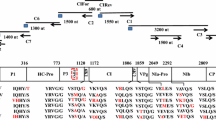Abstract
Complete genome sequences were obtained from two isolates of the carlavirus nerine latent virus from hippeastrum and narcissus plants, two isolates of the potyvirus hippeastrum mosaic virus from a hippeastrum plant, and one isolate each of the potyviruses narcissus degeneration virus, narcissus yellow stripe virus and Vallota speciosa virus from narcissus plants. Proposals are made to clarify the current confusion surrounding the naming of some of these viruses.

Similar content being viewed by others
References
Adams MJ, Antinow JF, Bar-Joseph M, Brunt AA, Candresse T, Foster GD, Martelli GP, Milne RG, Fauquet CM (2004) The new plant family Flexiviridae and assessment of molecular criteria for species demarcation. Arch Virol 149:1045–1060
Adams MJ, Antoniw JF, Fauquet CM (2005) Molecular criteria for genus and species discrimination within the family Potyviridae. Arch Virol 150:459–479
Alexandre MAV, Duarte LML, Rivas EB, Cilli A, Harakava R, Galleti SR, Kitajima EW (2011) Hippeastrum mosaic virus diagnosed in hippeastrum and eucharis in Brazil. J Plant Pathol 93:643–649
Brunt AA, Atkey PT (1967) Rapid detection of narcissus yellow stripe and two other filamentous viruses in crude negatively stained narcissus sap. Rep Glasshouse Res Inst 1966:155–159
Brunt AA (1995) Narcissus. In: Loebenstein G, Lawson RH, Brunt AA (eds) Virus and virus-like diseases of bulb and flower crops. Wiley, Chichester, pp 322–334
Chen J, Chen JP, Langeveld SA, Derks AFLM, Adams MJ (2003) Molecular characterization of carla- and potyviruses from narcissus in China. J Phytopathol 151:1–4
Chen J, Shi YH, Lu YW, Adams MJ, Chen JP (2006) Narcissus symptomless virus: a new carlavirus of daffodils. Arch Virol 151:2261–2267
Drummond AJ, Ashton B, Buxton S, Cheung M, Cooper A, Duran C, Field M, Heled J, Kearse M, Markowitz S, Moir R, Stones-Havas S, Sturrock S, Thierer T, Wilson A (2011) Geneious Pro v5.5.6. http://www.geneious.com
Hakkaart FA (1972) Virusziekten van Nerine. Jversl Inst Plziektenk Onderz, Wageningen 1971:105–106
Langeveld SA, Derks AFLM, Konicheva V, Muñoz D, Zhin-nan C, Denkova ST, Lemmers MEC, Boonekamp PM (1997) Molecular identification of potyviruses in Dutch stocks of Narcissus. Acta Hort 430:641–648
Maat DZ, Huttinga H, Hakkaart FA (1978) Nerine latent virus, some properties and serological detectability in Nerine bowdenii. Neth J Plant Pathol 84:47–59
Morschel JR (1966). Recorded plant diseases in and outside Australia. Part 4: Forest trees and Ornamental Plants. Commonwealth Department of Health Division of Plant Quarantine, Canberra, 79 p
Pearson MN, Cohen D, Cowell SJ, Jones D, Blouin A, Lebas BSM, Shiller JB, Clover GRC (2009) A survey of viruses of flower bulbs in New Zealand. Australas Plant Pathol 38:305–309
Raj SK, Snehi SK, Kumar S, Khan MS (2009) First molecular detection and identification of a potyvirus associated with severe mosaic disease of amaryllis (Hippeastrum hybridum Hort.) in India. Australas Plant Dis Note 4:50–53
Roossinck MJ, Saha P, Wiley GB, Quan J, White JD, Lai H, Chavarría F, Shen G, Roe BA (2010) Ecogenomics: using massively parallel pyrosequencing to understand virus ecology. Mol Ecol 19(Suppl 1):81–88
Tamura K, Peterson D, Peterson N, Stecher G, Nei M, Kumar S (2011) MEGA5: Molecular evolutionary genetics analysis using maximum likelihood, evolutionary distance, and maximum parsimony methods. Mol Biol Evol. doi:10.1093/molbev/msr121
Valli A, Lo′pez-Moya JJ, Garcı′a JA (2007) Recombination and gene duplication in the evolutionary diversification of P1 proteins in the family Potyviridae. J Gen Virol 88:1016–1028
Ward LI, Veerakone S, Tang J, Clover GRG (2009) First report of narcissus degeneration virus, narcissus late season yellows virus, and narcissus symptomless virus on Narcissus in New Zealand. Plant Dis 93:964
Wylie SJ, Nouri S, Coutts BA, Jones MGK (2010) Narcissus late season yellows virus and Vallota speciosa virus found infecting domestic and wild populations of Narcissus species in Australia. Arch Virol 155:1171–1174
Wylie SJ, Luo H, Li H, Jones MGK (2012) Multiple polyadenylated RNA viruses detected in pooled cultivated and wild plant samples. Arch Virol 157:271–284
Acknowledgments
This study was funded by Australian Research Council Linkage Grant LP110200180.
Author information
Authors and Affiliations
Corresponding author
Electronic supplementary material
Below is the link to the electronic supplementary material.
Rights and permissions
About this article
Cite this article
Wylie, S.J., Jones, M.G.K. Complete genome sequences of seven carlavirus and potyvirus isolates from Narcissus and Hippeastrum plants in Australia, and proposals to clarify their naming. Arch Virol 157, 1471–1480 (2012). https://doi.org/10.1007/s00705-012-1319-6
Received:
Accepted:
Published:
Issue Date:
DOI: https://doi.org/10.1007/s00705-012-1319-6




